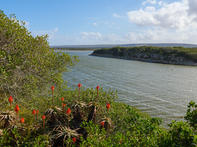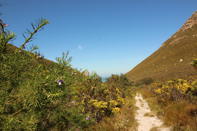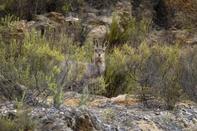De Hoopvlei
The De Hoopvlei hike is a 24 km route that takes around 6 hours to complete and is relatively easy. Starting on the calcrete cliffs behind the homestead, follow the edge of the vlei as best you can. You’ll spot beautiful indigenous flora such as bitou bushes and gnarled milkwoods along the path. Fauna that you might see includes cape fox, bontebok, eland and birds like weavers and seagulls.

This hike follows the eastern shore of the vlei from opposite the De Hoop homestead, where coastal dunes block its access to the sea. You’ll make your way along the cliffs through milkwood and thorn bush. The route is really straightforward once you follow the vlei edge. Where the cliffs give way to a sandy shoreline towards the south, you can take a closer look at the lake ecosystem.
Along the hike, you might also see some of the reserve's large animals that congregate near the vlei in dry times, while mongoose and elusive otters are known more by their spoor in the mud than by sightings.
Harold Porter Gardens
The Harold Porter National Botanical Gardens is a truly delightful place to spend a few hours, to stroll in and discover the delights of the fynbos and mysteries of the mountain kloofs - it was not without good reason that this site was chosen as a botanical garden.
Near the entrance there are numerous short paths through the formal gardens, where mimetes, proteas, pincushions and other plants burst out in floral celebration. With permit clutched in sweaty hand, you can venture up the rough path into the bowels of Leopard's Kloof, where the booming sound of the far-off waterfall envelopes you. At the base of the impressive falls you will find a large pool so typical of the treasures that one discovers in the large gorges of the folded mountains.
The signposted path leads off to the left (looking landward) of the planted gardens, and zigzags up the mountain slope to the left (west) of Tierkloof. After a 200 m climb, the path levels off, before heading up a lesser gradient to meet the river a way above the waterfall. To get to the top of the falls is a steep and potentially dangerous manoeuvre from the path, but the views over Betty's Bay and the sea are elevating. Return the way you came.
Fernkloof Nature Reserve

There is a 40 km network of paths in Fernkloof Nature Reserve, which lies in the lower western extreme of the Kleinriviersberge. Your choice of walk ranges from an easy 4.5 km self-guided nature trail to steeper routes within the 1 500 ha reserve.
As you walk up the main valley, the most conspicuous plants are the rounded leucospermum bushes which erupt in yellow-white pincushion heads in early summer. There are also Protea cynaroides (King protea) specimens, larger leucadendrons, and the tall sparse stems of Gnidia oppositifolia shrubs, which grow up to 3 m tall. A contour path runs along the left slope above the valley floor, winding in and out of the spurs below the narrow tiers of rock.
Caledon Wildflower Garden

This 214 ha wildflower and fynbos reserve is famous for its 50 ha wildflower garden, which has attracted visitors in spring since its opening in 1927. A 10 km circular walk leads up the southern slopes of the Swartberg to the far northeastern corner of this narrow reserve - although the summit (1 089 m) lies well outside the reserve boundary. The tearoom is open only during the spring wildflower season, but the toilets and braai facilities are available all year. There is very little natural water on the trail, so be sure to fill up before you leave the visitors' area. Be on the lookout for the elusive klipspringer as well!
The reserve is open only during daylight hours, though camping facilities are available at the nearby Caledon mineral spa. It is found to the north of the national road, behind the provincial hospital; turn left where the road to Caledon branches off the N2 to the right. From the highest point reached on the Swartberg crest ridge (834 m), you gain views over the rolling wheat lands of Caledon and the folded Swartberg range.
Bredasdorp Mountain Reserve
As in the case of the Caledon Wildflower and Nature Reserve, this 800 ha reserve encloses a smaller (86 ha) formal wildflower reserve within its borders. Although the hill around which the reserve lies can hardly be called a mountain, its mainly shale base is a remnant of those loftier folded mountains to the north. About 20 km of nature trails have been laid out within the reserve, complete with occasional resting shelters.
The vegetation in the reserve is a patchwork of fynbos and renosterveld, two main components of the Cape flora. Renosterveld is named after the predominant renosterbos, but this plant's overwhelming dominance suggests that the renosterveld is a degraded habitat. Today, the fertile soils on which renosterveld grows have been all but completely taken over for cultivation. There are consequently many rare and endangered plants protected in this ecological island, one of which is the Bredasdorp lily, otherwise called the 'Brand lelie'.
 When headed to the Overberg, you’ll find a graveyard of ships and floral riches beyond compare along a coastline patrolled by great white ...
When headed to the Overberg, you’ll find a graveyard of ships and floral riches beyond compare along a coastline patrolled by great white ...